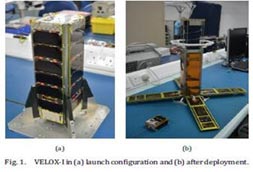
ZigBee Technology: Lightweight Wireless Solutions for Satellites

With the weight of payloads being a major constraint in satellite design, constructing a lightweight, low power-consuming, wireless communication system to do away with cabling inside the satellite has always been a challenge for system designers.
The engineering team at the Satellite Research Centre of Nanyang Technological University in Singapore launched VELOX-I, which consists of a nanosatellite weighing 3.5 kg and a piggyback picosatellite weighing 1.5 kg, from the two highest points on campus.
Designed to test the hypothesis that ZigBee, a cheap but powerful land-based wireless system, will perform equally well in space, both miniature satellites were configured with a ZigBee wireless network and equipped with small sensor nodes. These nodes perform functions such as local sensing, distributed computing and data-gathering within the satellite to support intra-satellite communications.
The satellites were found to be able to maintain inter-satellite communications with each other over remarkably long distances.
This experiment marks a breakthrough in aeronautical engineering, having been designed to evaluate the performance of WSNs in space. After conducting Received Signal Strength Indicator tests on the satellites' radio frequency modules, a maximum range of 1 km was found to be achievable for inter-satellite communication in the campus environment. An even longer communication range can be expected in free space, due to the absence of signal attenuation caused by fading and diffraction.
To estimate the range of inter-satellite communication in free space, the team applied a link budget analysis based on the Friis transmission equation, deriving an average theoretical distance of 4.186 km and a maximum of 15.552 km. Published in the special issue of Unmanned Systems, these findings present a compelling case for further studies into inter-satellite communication systems with more complex designs.
The team also found that by replacing internally wired connections with wireless links, a satellite's mass could be reduced by as much as 10%. With the twin pressures of minimising development costs and maximising risk diversification imposing major constraints on satellite design, the production of comprehensive yet lightweight systems could benefit significantly from WSNs.
Although WSNs have been used in a wide range of applications in recent years, their use in space applications has, until now, remained limited. The Singaporean team's data-driven survey has established a sound platform for future formation-flying satellite missions, and seems poised to create subsequent revolutions in space.
Their report appears in Unmanned Systems' special issue on wireless sensor networks and applications.
About World Scientific Publishing Co.
World Scientific Publishing is a leading independent publisher of books and journals for the scholarly, research and professional communities. The company publishes about 500 books annually and more than 120 journals in various fields. World Scientific collaborates with prestigious organisations like the Nobel Foundation, US National Academies Press, as well as its subsidiary, the Imperial College Press, amongst others, to bring high quality academic and professional content to researchers and academics worldwide. To find out more about World Scientific, please visit www.worldscientific.com.
Media Contact:
Jason Lim Chongjin
Senior Marketing/Corporate Communications Executive
Tel: (65) 64665775, Ext. 247
Email: cjlim@wspc.com.sg












